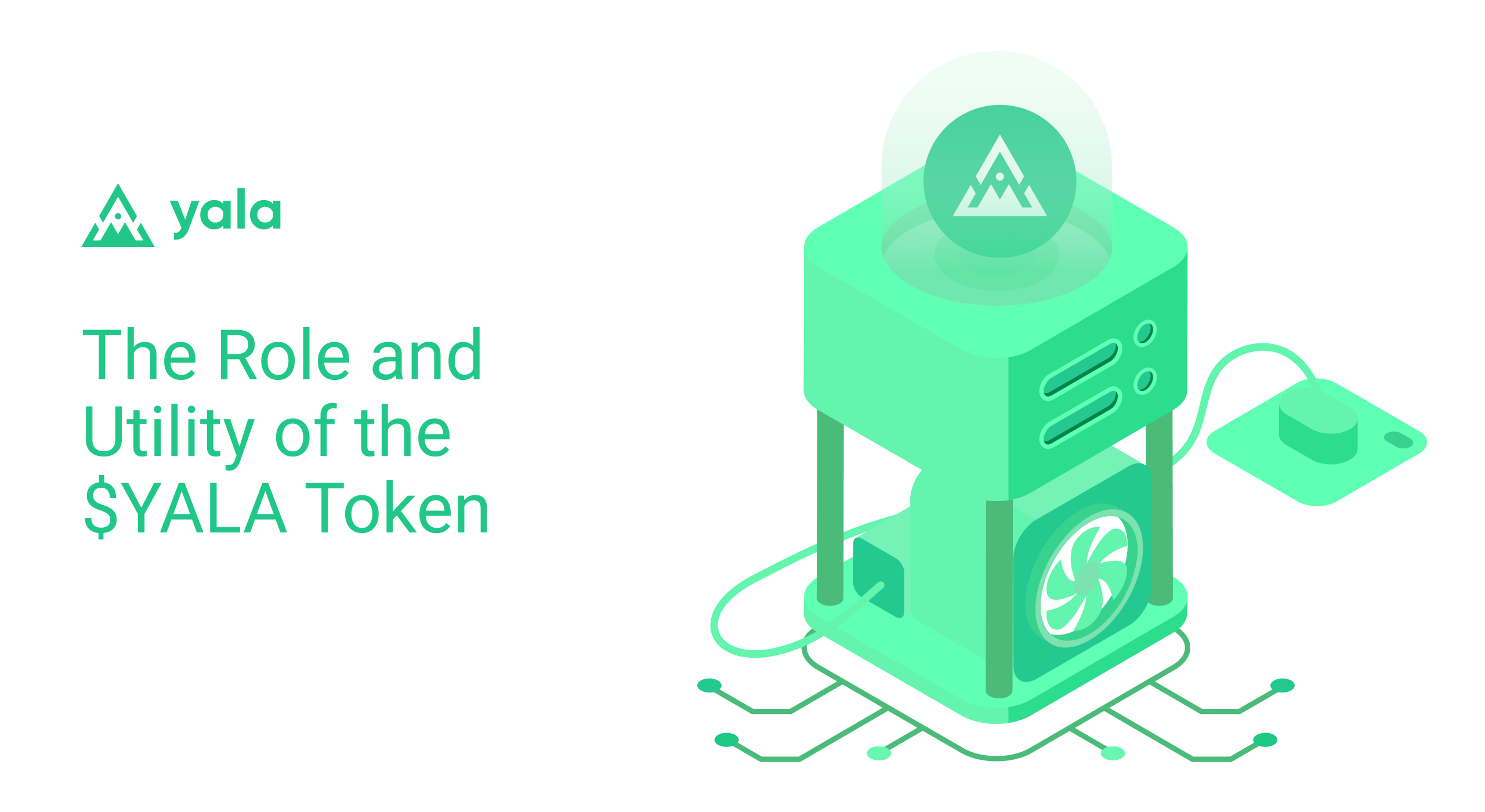The Role and Utility of the $YALA Token
A deep-dive into how the $YALA token functions and why it's so important for the Yala ecosystem.

Let's dive into the $YALA token and its role in the Yala ecosystem.
$YALA is essential as it contributes to the well functioning of the protocol through recapitalization, mechanisms for maintaining systemic stability, and eventually governing the platform. We'll explain how $YALA functions and why it's so important for the Yala ecosystem.
How Does the Yala Protocol Work?
Collateralized Debt Positions (CDPs)
CDPs allow users to generate $YU by locking up collateral assets such as Bitcoin and other Bitcoin-native assets. Here's how it works:
- Depositing Collateral: Users create their own Vault, which acts as a personalized account for managing their collateral and debt. The exact process depends on the operational mode they choose:
- Lite Mode: In this user-friendly mode, Yala’s automated system handles most of the backend processes. Here, YBTC (the tokenized representation of Bitcoin) is automatically generated and deposited into the smart contract on behalf of the user.
- Pro Mode: For advanced users, this mode offers greater control. Users manage the process themselves, directly interacting with the protocol to deposit their YBTC into the smart contract.
- Institution Mode: Tailored for institutions and large BTC holders, offering maximum control by keeping BTC locked in user-managed Bitcoin wallets with mainnet-level security.
You can read more about it in this article.
- Generating Stablecoins: Once the collateral is locked, users can generate $YU, which is soft-pegged to the US dollar. $YU can be used for various financial activities, such as payments, savings, or collateral management. The amount of $YU that can be minted is determined by a Loan-to-Value (LTV) ratio, initially set by the Yala Foundation that will later transition into System Governance by the $YALA holders, ensuring that the system remains adequately collateralized and stable.
- Maintaining Collateralization: The Yala Foundation has also initially set a liquidation threshold to maintain the peg. This means that the value of the collateral must always be higher than the value of the stablecoins to maintain the system's stability. If the collateral value drops below a certain threshold, the CDP may be liquidated to cover the outstanding stablecoin debt. In this Medium article, you can read about different DeFi strategies.
What is the $YALA Token?
The $YALA token is a cornerstone of the Yala ecosystem combining reward, governance, and security functionalities. It incentivizes participation, enhances system stability, and offers holders influence over the protocol's evolution.
Over time, $YALA is designed to transition from a rewards and utility token into a robust governance tool, ensuring the protocol remains adaptive, secure, and community-driven.
$YALA is designed to serve multiple functions within the ecosystem, making it indispensable for the platform's operation.
1. Stability Pool Rewards
Participants in the Stability Pool deposit $YU to absorb debt from liquidated vaults. In return, they are rewarded with $YALA tokens, along with a portion of the liquidated collateral and stability fees.
This incentivizes users to maintain the platform’s liquidity while ensuring its stability during market fluctuations.
Let’s break down how this works, including the proportional distribution of collateral to participants.
2. How Do Rewards Work?
- Debt Repayment via Stability Pool:When a vault is liquidated due to its Individual Collateral Ratio (ICR) falling below the Minimum Collateral Ratio (MCR), the debt of the vault is repaid using $YU deposited in the Stability Pool. This ensures the protocol remains solvent and stable.
- Collateral Redistribution:Once the debt is repaid, the corresponding collateral from the liquidated vault is distributed among Stability Pool participants. The distribution is proportional to the amount of $YU each participant has contributed to the pool.For example:
- If a vault’s debt of $666.67 is repaid using the Stability Pool, the corresponding collateral worth $666.67 is distributed.
- A depositor who owns 10% of the total $YU in the Stability Pool would receive 10% of the collateral, equating to $66.67.
- Additional Rewards:On top of collateral distribution, Stability Pool participants earn $YALA tokens as an incentive for maintaining liquidity. Stability fees collected from the liquidated Vault further reward participants, making this process financially attractive.
Illustrative Example
- Vault Owner: Deposits $1000 worth of Bitcoin as collateral and borrows $666.67 in $YU (MCR of 150%).
- Price Drop: Bitcoin’s value decreases, and the collateral drops to $800, resulting in an ICR of 120%, triggering liquidation.
- Liquidation Process:
- The $666.67 debt is repaid using $YU from the Stability Pool.
- Collateral worth $666.67 is redistributed to pool participants proportionally. A depositor holding 10% of the pool receives $66.67 in Bitcoin.
- Any remaining collateral ($800 − $666.67 = $133.33) is returned to the vault owner as surplus.
What Happens if the Stability Pool is Insufficient?
In scenarios where the Stability Pool cannot fully cover the debt, the remaining debt and collateral are redistributed proportionally across active vaults. This ensures that the system remains solvent, even in extreme situations.
3. Governance
As the protocol matures, $YALA becomes a vital governance token, empowering holders to:
- Vote on Key Decisions: Influence protocol parameters such as collateral ratios, fee rates, and stability mechanisms.
- Propose Upgrades: Advocate for protocol improvements that ensure long-term competitiveness and address user needs.
- Gauge Weight Voting: Direct $YALA emissions through holding $veYALA, ensuring resource allocation aligns with the community’s priorities.
By distributing governance power to the community, Yala ensures transparency and aligns its evolution with the interests of its users.
4. Crypto-economic Security
$YALA tokens play a crucial role in maintaining the platform’s cryptoeconomic security:
- Bridge Security: Stake $YALA to delegate and secure nodes on Yala’s Notary Bridge.
- Solver and Relayer Networks: Stake or restake $YALA to support the solvers or relayers network, ensuring seamless operations within Yala’s Unified Liquidity solution.
- Decentralized Verifier Networks (DVN): Stake or restake $YALA to secure $YU’s DVN, leveraging the decentralized infrastructure of LayerZero.
Conclusion
In this blog post, we've explored the role of the $YALA token. From its critical functions in governance to earning rewards for providing system stability, $YALA plays an important role in the Yala ecosystem. As Yala continues to innovate and grow, the token will play a pivotal role in its success, offering a robust and decentralized financial solution for users worldwide.
To stay updated on the progress of our indexer technology, feel free to follow our developments on GitHub.
Keep an eye on Yala as we keep pushing the boundaries of innovation and shaping the DeFi space's future.
About Yala
Yala is building a liquidity layer to unlock Bitcoin’s untapped yield across DeFi and RWAs. Users can deposit BTC and access seamless liquidity, enabling efficient capital movement and yield opportunities across ecosystems, chains, and protocols.

